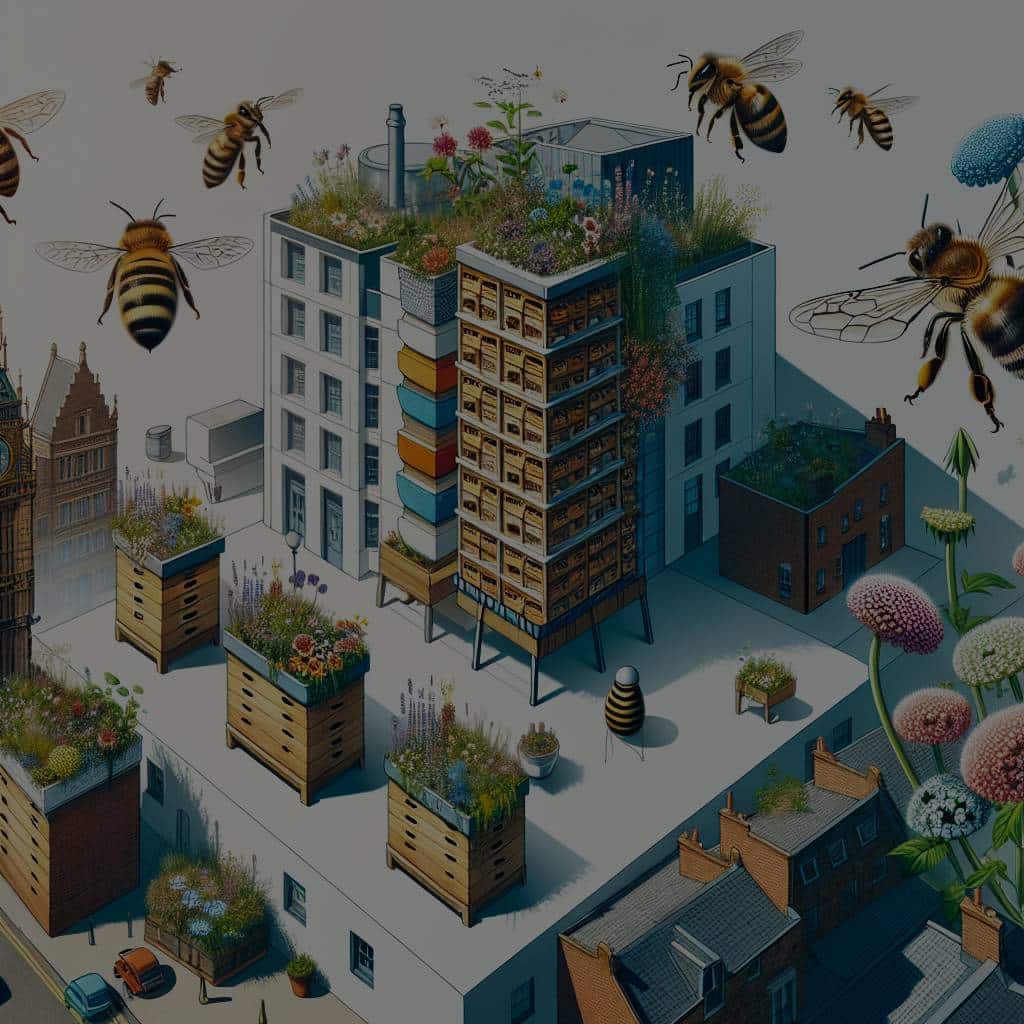Can urban beekeeping initiatives support biodiversity in UK cities?

In the heart of the UK’s bustling cities, an unexpected trend is taking root. Urban beekeeping, once a fairly obscure hobby, is now a considerable movement with considerable implications for local biodiversity. As urban scholars, it’s crucial for you to understand what’s buzzing in your local area, from the role of bees as crucial pollinators to the potential impact of urban beekeeping on city biodiversity.
Understanding the Role of Bees as Pollinators
Before we delve into the specifics of urban beekeeping, it’s important to understand the critical role bees play in our global ecosystem. Bees are among the most critical pollinators. They’re responsible for pollinating approximately 70 of the 100 crop species that feed 90% of the world.
Also read : What are the best approaches to introduce circular economy practices in UK businesses?
In cities, where green spaces are often sparse and fragmented, bees have a crucial role in supporting local plant diversity. They flit from flower to flower, transferring pollen and fertilising plants, which can lead to the creation of new seeds and the flourishing of local green spaces.
However, bees aren’t just honeybees. There’s incredible diversity in bee species, with over 20,000 known species worldwide. In the UK alone, there are nearly 250 species, many of which are solitary bees. These wild bees can sometimes be even more effective pollinators than their more famous hive-dwelling cousins.
Also to discover : How to prepare and adapt UK homes for the challenges of extreme weather events?
The Threat to Bees and Biodiversity
According to numerous studies, including those indexed on PubMed and Google Scholar, bees are under significant threat. Habitat loss, pesticide exposure, disease, and climate change are all contributing factors to the decline of bee populations.
In urban areas, the situation isn’t much better. Cities often lack the necessary biodiversity of plants to support a healthy bee population. Additionally, urban heat islands – areas with higher temperatures due to human activities – can further strain the already struggling bee populations.
The decline of bees isn’t just a concern for the bees themselves. It has significant implications for biodiversity. As primary pollinators, bees help to maintain and create diverse habitats and ecosystems. Their decline could lead to a decrease in the quantity and diversity of local flora, which in turn could impact other wildlife.
Urban Beekeeping: A Potential Solution?
Urban beekeeping, also known as city or rooftop beekeeping, has been hailed as a potential solution to the biodiversity crisis in cities. By introducing hives into urban areas, the theory is that cities can become habitats for bees, in turn promoting local biodiversity.
This concept isn’t as far-fetched as it might initially seem. Bees can thrive in cities, where there are often fewer pesticides and a longer flowering season due to the urban heat island effect. Some cities even have policies to encourage urban beekeeping, such as London’s "bee corridor," a 7-mile wildflower meadow intended to support the city’s bees.
Exploring the Evidence: Urban Beekeeping and Biodiversity
Urban beekeeping’s potential to support biodiversity isn’t just theoretical. Several studies, searchable on platforms like Google Scholar, have investigated this phenomenon, yielding promising results.
One such study conducted in London found that urban areas could support a surprisingly high diversity of bee species. Furthermore, the study found that managed honeybee hives could coexist with wild bees without outcompeting them for resources.
Similarly, a study on rooftop beekeeping in Detroit, USA, found that urban beekeeping could boost local pollinator populations, contributing to the maintenance and growth of green spaces within the city.
These studies suggest that urban beekeeping, when properly managed, could be an effective conservation strategy in cities. However, it’s important to note that urban beekeeping isn’t a one-size-fits-all solution. Its success can depend on a variety of factors, including local climate, available green spaces, and beekeeping practices.
Urban Beekeeping: More Than Just Hives
While introducing hives is a crucial part of urban beekeeping, it’s far from the only consideration. To truly support bees and biodiversity, cities need to consider a holistic approach that includes the creation and maintenance of green spaces, the planting of a diversity of native plants, and the reduction of pesticide use.
Urban beekeeping is a promising initiative, but it’s just one piece of the puzzle. In order to create cities that are not only hospitable to bees but also promote biodiversity, urban planners, policymakers, and citizens alike need to consider a range of intertwined factors. From creating green corridors to encouraging the growth of wildflowers in public spaces, there are many strategies that can make cities more bee-friendly.
In conclusion, while urban beekeeping alone might not be a silver bullet for biodiversity loss, it’s certainly a step in the right direction. And by understanding and promoting the role of bees in our urban ecosystems, we can help create cities that are not only more biodiverse but also greener, healthier, and more sustainable for all their inhabitants.
As urban scholars, it’s in your hands to champion these initiatives and create a buzz around urban beekeeping. So the next time you see a bee in your city, remember: they’re more than just city visitors. They’re small but mighty pollinators, playing a critical role in maintaining and enhancing urban biodiversity.
The Impact of Urban Beekeeping on Bee Communities Diversity
Understanding the relationship between urban beekeeping and bee communities diversity is crucial in assessing the potential of city beekeeping initiatives. Comprehensive studies on this topic, available on resources like Google Scholar, provide valuable insights into this.
Urban environments are characteristically different from natural habitats. They often present a unique set of challenges, including higher temperatures, fewer green spaces, and more pollutants. However, urban areas can also offer certain advantages. For example, a study published in Banaszak-Cibicka and Żmihorski’s research found that bees in urban areas could benefit from a longer flowering season, less pesticide exposure, and a diversity of floral resources.
Concretely, one study found an unexpectedly high diversity of bee species in urban green spaces, indicating that cities could potentially support a range of wild bees. These bees often exhibit different functional traits – attributes related to their behavior, physiology, and life history. For instance, some bees might prefer certain types of flowers, have differing body sizes, or show varying degrees of social behavior.
Having a high diversity of functional traits within bee communities is beneficial for urban biodiversity. Different bee species, each with their unique functional trait, can pollinate a wider array of plants. They can also provide a sort of insurance against environmental changes, as some species may be more resilient than others.
Therefore, urban beekeeping initiatives could potentially support not only bee abundance but also the bee species richness – a key component of biodiversity.
Conclusion: The Future of Urban Beekeeping
In conclusion, urban beekeeping initiatives hold a lot of promise for supporting biodiversity in UK cities. By encouraging the establishment and growth of bee communities in urban habitats, we can boost the pollination of a wide variety of plants, contributing to the enrichment of green spaces.
However, it’s crucial to remember that urban beekeeping isn’t a magic solution. It’s one part of a broader strategy for promoting biodiversity. Complementary measures, such as the creation and maintenance of green spaces, planting diverse native plants, and reducing pesticide use, are also essential.
Moreover, to ensure the sustainability of urban beekeeping, it’s important to consider the specific needs and characteristics of different bee species, focusing not only on honeybees but also on wild bees. This requires further research and continuous monitoring of bee populations in urban areas.
In the end, urban beekeeping is a movement that resonates with the larger goal of creating sustainable, biodiverse, and resilient cities. But the work doesn’t end with setting up a hive on a rooftop. It requires the collective effort of urban scholars, policymakers, and citizens alike.
So, let’s keep the conversation buzzing around urban beekeeping and biodiversity. Because every little helps – whether it’s turning a small balcony into a bee-friendly spot or advocating for city-wide policies that promote green spaces. And remember, the next time you spot a bee in the city, they’re not just city visitors; they’re tiny urban farmers helping to cultivate biodiversity in our concrete jungles.
